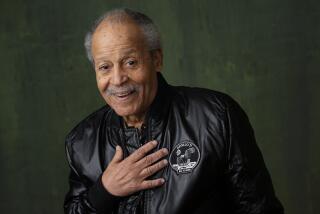Paul Haney, former ‘voice’ of manned space flight, dies at 80
- Share via
Reporting from Washington — Paul Haney, a former Washington journalist who went on to become the “voice” of manned space flight for NASA’s Gemini and Apollo programs, died Thursday at a nursing home in Alamogordo, N.M. He was 80.
Haney had been battling melanoma for more than two years and it had spread to his brain, according to the Alamogordo Funeral Home.
In 1958 he joined the recently created NASA as a public information officer after spending almost five years as a reporter for the Washington Evening Star.
His first task at the nascent space agency, he recalled in 2003 for the NASA Johnson Space Center Oral History Project, was to “try to figure out what a public information officer should do.” Mainly, he felt, it was to cut through bureaucracy and be as open as possible.
In 1963, Haney was promoted to chief of public affairs at the Manned Spacecraft Center in Houston, which eventually became the Johnson center. He soon took on the additional duty of providing commentary from Mission Control that was fed to broadcast television viewers.
He covered multiple flights during the Gemini program, which consisted of two-man missions designed to bridge the gap between the founding Mercury program and the Apollo program, which first sent people to the moon. Among the historic -- and tense -- moments Haney narrated for the public was the arrival of Apollo 8 at the moon on Christmas Eve of 1968. The world waited as the spacecraft went to the far side of the moon into a communications blackout, after which it would be known whether the crew had successfully entered orbit around the celestial body. After minutes of silence, Haney exclaimed, “We got it! We’ve got it! Apollo 8 now in lunar orbit.”
Paul Prichard Haney was born July 20, 1928, in Akron, Ohio. To pay his way through Ohio’s Kent State University, he worked nights for the Associated Press. He served in the Navy during the Korean War before going to work for the Star.
Haney said in the 2003 oral history project that his experience covering space before taking the NASA job was largely limited to a man-on-the street piece he did for the Star after the Soviets launched the Sputnik satellite in 1957. Nor was he as enamored of flight as the general public or the man who preceded him as the voice of NASA’s missions, Lt. Col. John A. Powers.
His job required managing some of the darker days in NASA’s history, as when a plane carrying two Gemini crew members crashed in St. Louis in 1965, killing both astronauts. And there was also the Jan. 27, 1967, fire on the pad of Apollo 1 that left three astronauts dead.
Haney repeatedly clashed with agency administrators, such as chief astronaut Donald K. “Deke” Slayton, over press access and Haney’s dual roles as mission commentator and public affairs official. Haney chose to quit NASA in 1969 rather than be reassigned to a position in Washington. He told the Washington Post in April of that year that he was especially bitter that he would miss the first lunar landing, which took place July 20, 1969.
The rest of his career included doing NASA commentary for Independent Television News in London and writing for the Economist magazine and the Evening Post in Charleston, S.C.
His first marriage to the former Jane Bramley ended in divorce.
Survivors include his wife, Janet Haney; two daughters from his first marriage; a stepson; a sister; and seven grandchildren.
Krystal writes for the Washington Post.
More to Read
Start your day right
Sign up for Essential California for the L.A. Times biggest news, features and recommendations in your inbox six days a week.
You may occasionally receive promotional content from the Los Angeles Times.






